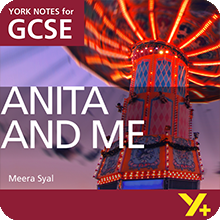Your Assessment
Read through the answer below and decide what level to give it. Use the Hints & Tips to help you make your assessment.
- how and why Meena changes
- how Syal presents these changes
Meena grows as a character during the novel. At its centre seems to be the question of truth. In the preface the adult Meena tricks us with a fake personal history, which she tells to boyfriends. Then Chapter 1 opens with her pleading, ‘I’m not lying, honest, papa.’ He thinks she has stolen a shilling to buy sweets – which she has. She also admits to ‘harmless fabrications’ that make life more interesting, and to more serious ‘whoppers’ to get herself out of trouble. She is still telling wild stories much later, when she tells the Ballbearings women that Nanima is a mine owner and speaks Russian. Her telling the police the truth about Tracey is an important turning point. It shows she knows that honesty is important at times.
It is in her relationship with Anita that Meena develops most. At first it is very unbalanced. Meena admires and trusts Anita, for example believing that the sailor in an advert is Anita’s father. Later, Anita sets the tone for the friendship by snatching Meena’s sweets and going off, knowing Meena will follow. Meena admits that she felt ‘ privileged’ to be in her company.
Anita encourages Meena to be more daring and rebellious, like when they both anger Mr Christmas by ‘whooping’. Their going into the Big House woods is an example of Anita making Meena more adventurous, but Meena goes further by going right up to the statue. This happens just after another sign that the relationship is changing: Meena protects Anita from knowing that ‘the Poet’ is having sex with Deirdre. This shows that Meena cares about Anita, in a motherly sort of way. She also shows that she cares when she tries to comfort Anita after Deirdre has left.
Meena also changes in how she sees racism, and this affects her friendship. Living in a village, she has been protected from racism, although it was on the increase in Britain at the start of the 1970s. Early on, she is shocked as if she has been ‘punched’ by the elderly driver who ‘casually’ abuses her. The image shows how hurt she feels. When she hears Sam’s racist heckling she is also shocked, because she saw him as a ‘mate’, but she has the independence to call Anita a ‘stupid cow’ for being impressed. This eventually develops into Meena rejecting Anita for boasting about her part in a racist attack. It is as if she makes herself fall from Trixie as a way to break from Anita.
Meena’s anti-racism is linked to another way in which she develops: her acceptance of herself and her Indian heritage. This is partly thanks to Nanima, who is a direct link to India and tells exciting stories that make Meena want to go there. Nanima also accepts Meena as a ‘junglee’, meaning a wild girl. This helps Meena to accept herself and stop wanting to be white like all the girls in Jackie magazine, published before the media became aware of different ethnic groups.
Meena develops most through ‘absorbing’ the losses of Nanima, Robert and Anita, ‘like rain on parched earth’. This image shows that the losses seemed natural, like she needed them. Syal makes her first-person narrator tell us about this important change herself rather than presenting it through action and dialogue. Her ‘sense of displacement ... carried round like a curse’ disappears. In the end she is strengthened by suffering and looks forward to her new future.
